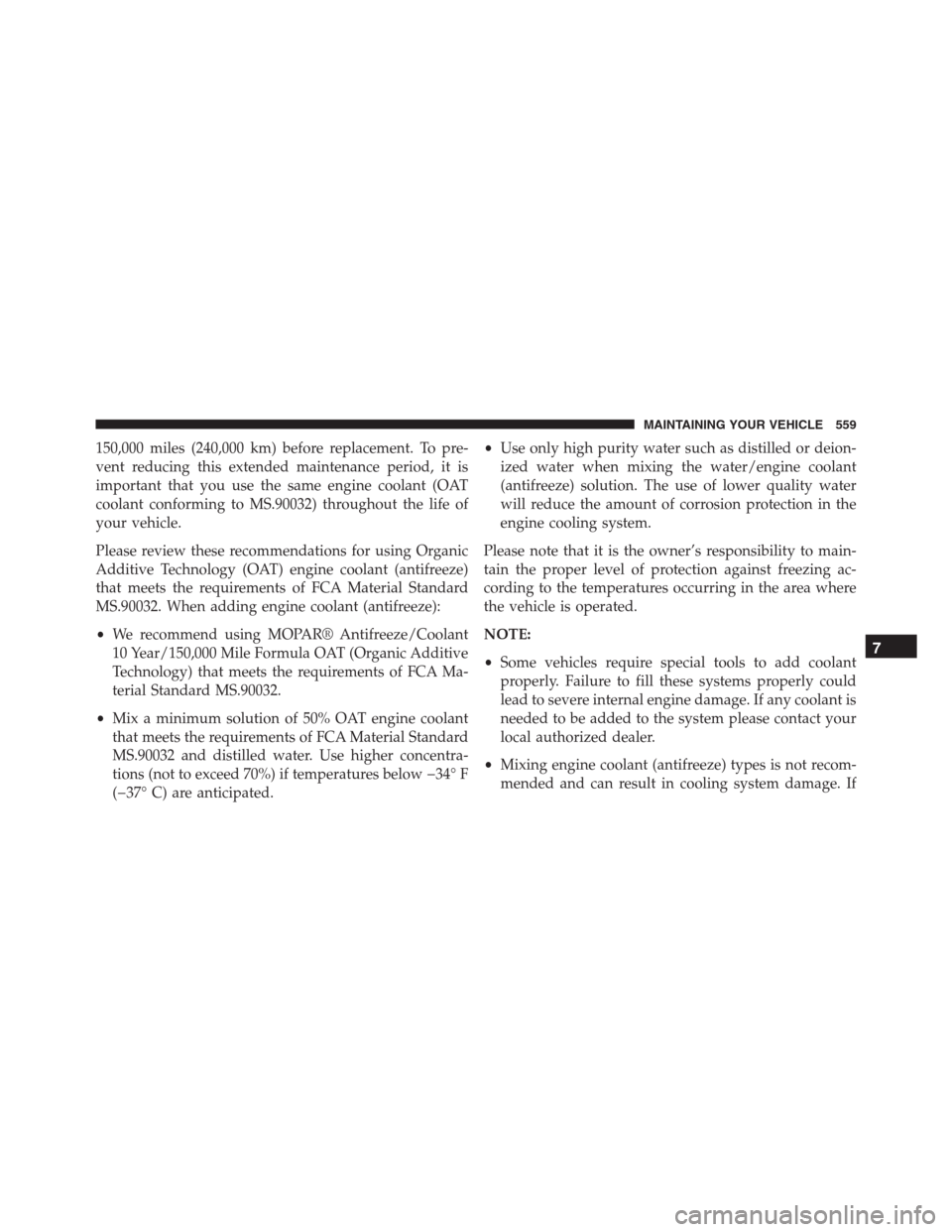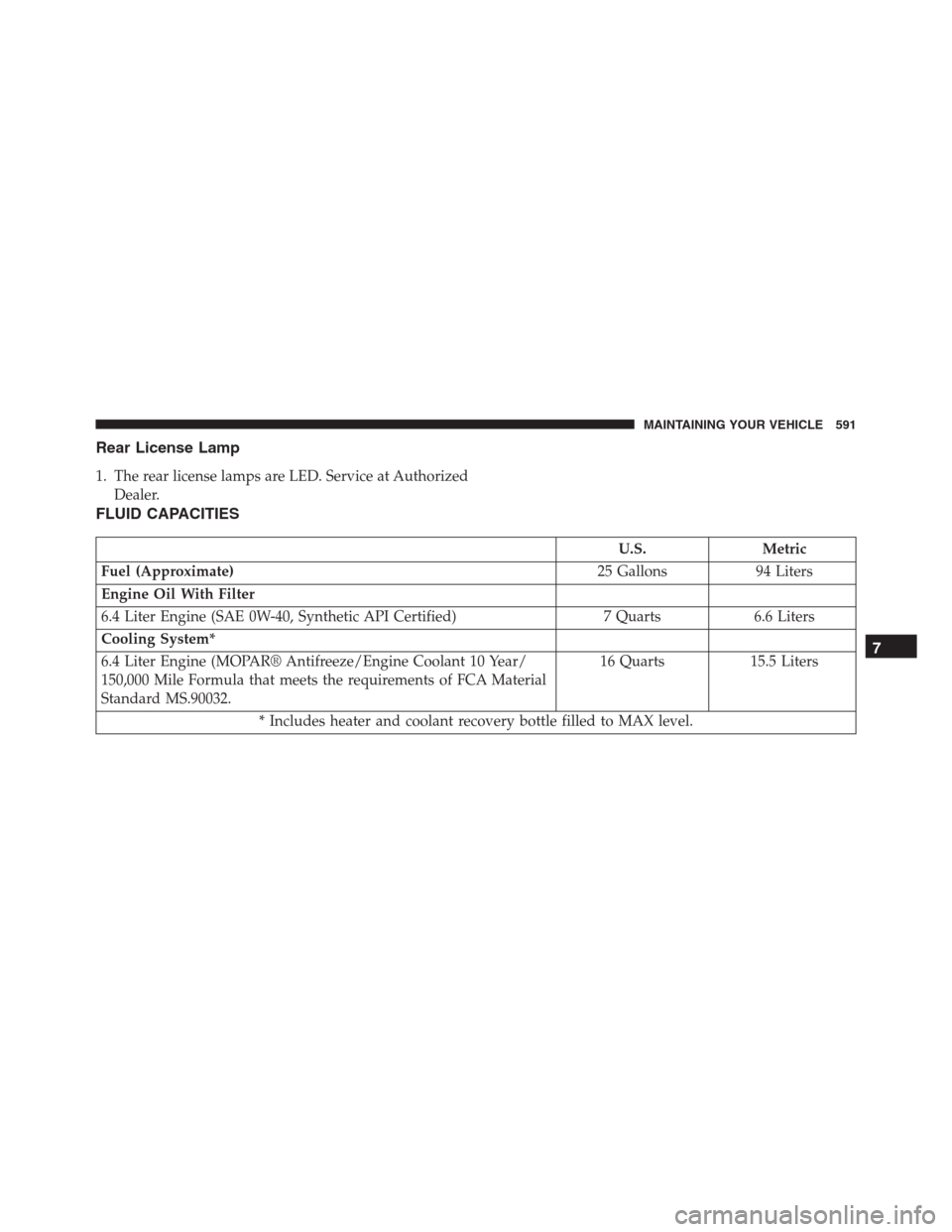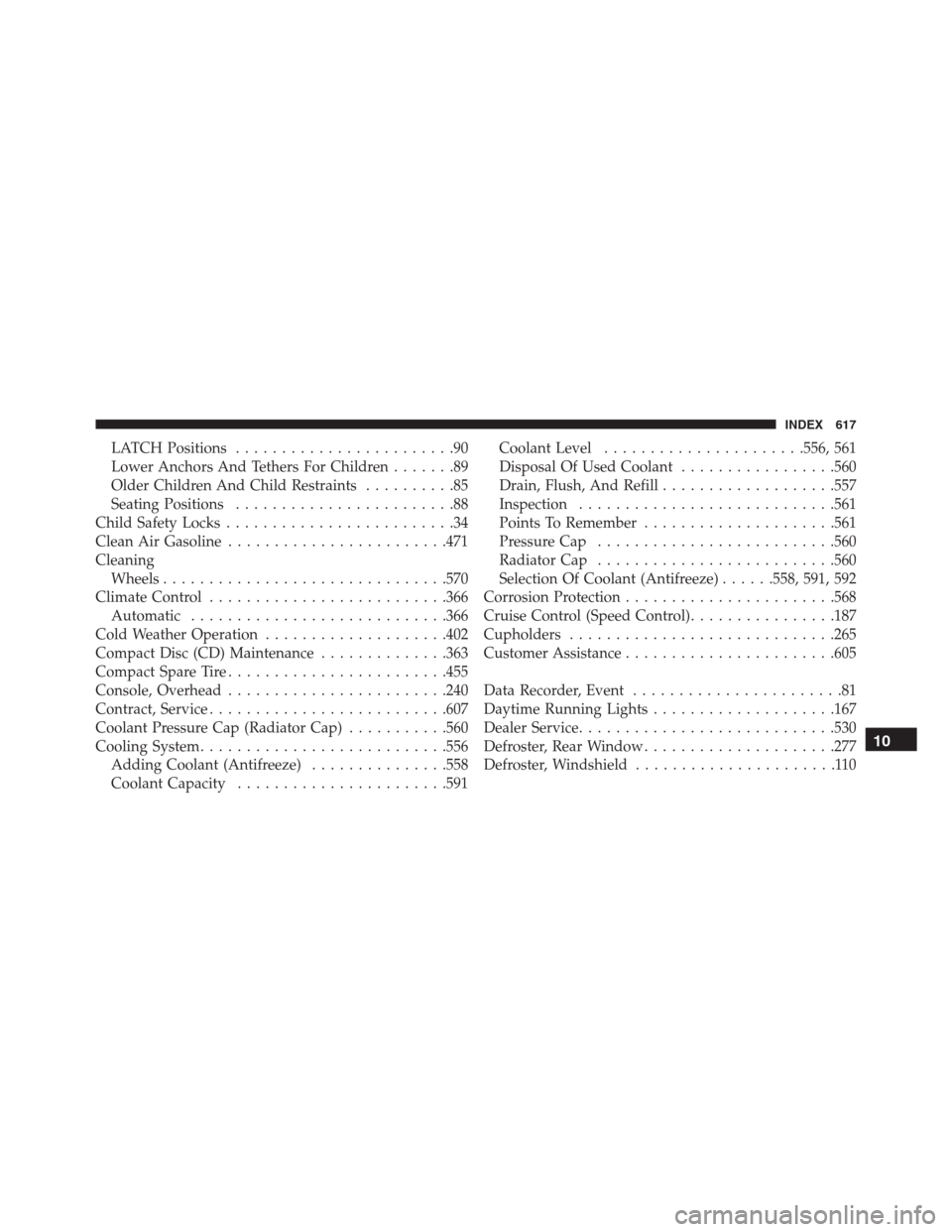2015 JEEP GRAND CHEROKEE coolant level
[x] Cancel search: coolant levelPage 291 of 636

CAUTION!
Driving with a hot engine cooling system could
damage your vehicle. If the temperature gauge reads
“H” pull over and stop the vehicle. Idle the vehicle
with the air conditioner turned off until the pointer
drops back into the normal range. If the pointer
remains on the “H” and you hear continuous chimes,
turn the engine off immediately and call an autho-
rized dealer for service.
WARNING!
A hot engine cooling system is dangerous. You or
others could be badly burned by steam or boiling
coolant. You may want to call an authorized dealer
for service if your vehicle overheats. If you decide to
look under the hood yourself, see “Maintaining Your
(Continued)
WARNING!(Continued)
Vehicle”. Follow the warnings under the Cooling
System Pressure Cap paragraph.
12. Brake Warning Light
This light monitors various brake functions,
including brake fluid level and parking brake
application. If the brake light turns on it may
indicate that the parking brake is applied, that
the brake fluid level is low, or that there is a problem with
the anti-lock brake system reservoir.
If the light remains on when the parking brake has been
disengaged, and the fluid level is at the full mark on the
master cylinder reservoir, it indicates a possible brake
hydraulic system malfunction or that a problem with the
Brake Booster has been detected by the Anti-Lock Brake
System (ABS) / Electronic Stability Control (ESC) system.
In this case, the light will remain on until the condition
4
UNDERSTANDING YOUR INSTRUMENT PANEL 289
Page 561 of 636

150,000 miles (240,000 km) before replacement. To pre-
vent reducing this extended maintenance period, it is
important that you use the same engine coolant (OAT
coolant conforming to MS.90032) throughout the life of
your vehicle.
Please review these recommendations for using Organic
Additive Technology (OAT) engine coolant (antifreeze)
that meets the requirements of FCA Material Standard
MS.90032. When adding engine coolant (antifreeze):
•We recommend using MOPAR® Antifreeze/Coolant
10 Year/150,000 Mile Formula OAT (Organic Additive
Technology) that meets the requirements of FCA Ma-
terial Standard MS.90032.
•Mix a minimum solution of 50% OAT engine coolant
that meets the requirements of FCA Material Standard
MS.90032 and distilled water. Use higher concentra-
tions (not to exceed 70%) if temperatures below �34° F
(�37° C) are anticipated.•Use only high purity water such as distilled or deion-
ized water when mixing the water/engine coolant
(antifreeze) solution. The use of lower quality water
will reduce the amount of corrosion protection in the
engine cooling system.
Please note that it is the owner’s responsibility to main-
tain the proper level of protection against freezing ac-
cording to the temperatures occurring in the area where
the vehicle is operated.
NOTE:
•Some vehicles require special tools to add coolant
properly. Failure to fill these systems properly could
lead to severe internal engine damage. If any coolant is
needed to be added to the system please contact your
local authorized dealer.
•Mixing engine coolant (antifreeze) types is not recom-
mended and can result in cooling system damage. If
7
MAINTAINING YOUR VEHICLE 559
Page 563 of 636

puddles on the ground. If ingested by a child or pet, seek
emergency assistance immediately. Clean up any ground
spills immediately.
Coolant Level
The coolant bottle provides a quick visual method for
determining that the coolant level is adequate. With the
engine OFF and cold, the level of the engine coolant
(antifreeze) in the bottle should be between the ranges
indicated on the bottle.
The radiator normally remains completely full, so there is
no need to remove the radiator/coolant pressure cap
unless checking for engine coolant (antifreeze) freeze
point or replacing coolant. Advise your service attendant
of this. As long as the engine operating temperature is
satisfactory, the coolant bottle need only be checked once
a month.When additional engine coolant (antifreeze) is needed to
maintain the proper level, only OAT coolant that meets
the requirements of FCA Material Standard MS.90032
should be added to the coolant bottle. Do not overfill.Points To Remember
NOTE:When the vehicle is stopped after a few miles/
kilometers of operation, you may observe vapor coming
from the front of the engine compartment. This is nor-
mally a result of moisture from rain, snow, or high
humidity accumulating on the radiator and being vapor-
ized when the thermostat opens, allowing hot engine
coolant (antifreeze) to enter the radiator.
7
MAINTAINING YOUR VEHICLE 561
Page 593 of 636

Rear License Lamp
1. The rear license lamps are LED. Service at Authorized
Dealer.
FLUID CAPACITIES
U.S. Metric
Fuel (Approximate)25 Gallons 94 Liters
Engine Oil With Filter
6.4 Liter Engine (SAE 0W-40, Synthetic API Certified) 7 Quarts 6.6 Liters
Cooling System*
6.4 Liter Engine (MOPAR® Antifreeze/Engine Coolant 10 Year/
150,000 Mile Formula that meets the requirements of FCA Material
Standard MS.90032.16 Quarts 15.5 Liters
* Includes heater and coolant recovery bottle filled to MAX level.
7
MAINTAINING YOUR VEHICLE 591
Page 599 of 636

Your authorized dealer will reset the oil change indicator
message after completing the scheduled oil change. If a
scheduled oil change is performed by someone other
than your authorized dealer, the message can be reset by
referring to the steps described under “Driver Informa-
tion Display (DID)” in “Understanding Your Instrument
Panel” for further information.
At Each Stop For Fuel
•Check the engine oil level. Refer to “Maintenance
Procedures/Engine Oil” in “Maintaining Your Ve-
hicle” for further information.
•Check the windshield washer solvent and add if
required.
Once A Month
•Check tire pressure and look for unusual wear or
damage.•Inspect the battery, and clean and tighten the terminals
as required.
•Check the fluid levels of the coolant reservoir, brake
master cylinder, and power steering, and add as
needed.
•Check all lights and other electrical items for correct
operation.
At Each Oil Change
•Change the engine oil filter.
•Inspect the brake hoses and lines.
CAUTION!
Failure to perform the required maintenance items
may result in damage to the vehicle.
8
MAINTENANCE SCHEDULES 597
Page 617 of 636

Alarm (Security Alarm)..................19, 286
Alterations/Modifications, Vehicle...............9
Antifreeze (Engine Coolant)...............558, 591
Disposal..............................560
Anti-Lock Brake System (ABS)................426
Anti-Lock Warning Light....................286
Appearance Care.........................568
Auto Down Power Windows..................42
Automatic Door Locks......................34
Automatic Headlights......................166
Automatic High Beams.....................166
Automatic Temperature Control (ATC).......366, 374
Automatic Transmission.................407, 568
Adding Fluid..........................568
Autostick.............................414
Fluid And Filter Changes..................568
Fluid Change..........................568
Fluid Level Check...................566, 567
Fluid Type.........................566, 593Gear Ranges...........................409
Special Additives.......................567
Autostick...............................414
Auxiliary Electrical Outlet (Power Outlet)........259
Auxiliary Power Outlet.....................259
Axle Fluid..............................593
Battery.................................540
Keyless Transmitter Replacement (RKE)........26
Belts, Seat...............................109
Blind Spot Monitoring......................132
Body Mechanism Lubrication.................546
B-Pillar Location..........................443
Brake Assist System.......................427
Brake Control System, Electronic..............426
Brake Fluid..........................563, 593
Brake System.........................425, 562
Anti-Lock (ABS).....................425, 426
Fluid Check...........................563
10
INDEX 615
Page 619 of 636

LATCH Positions........................90
Lower Anchors And Tethers For Children.......89
Older Children And Child Restraints..........85
Seating Positions........................88
Child Safety Locks.........................34
Clean Air Gasoline........................471
Cleaning
Wheels...............................570
Climate Control..........................366
Automatic............................366
Cold Weather Operation....................402
Compact Disc (CD) Maintenance..............363
Compact Spare Tire........................455
Console, Overhead........................240
Contract, Service..........................607
Coolant Pressure Cap (Radiator Cap)...........560
Cooling System...........................556
Adding Coolant (Antifreeze)...............558
Coolant Capacity.......................591Coolant Level......................556, 561
Disposal Of Used Coolant.................560
Drain, Flush, And Refill...................557
Inspection............................561
Points To Remember.....................561
Pressure Cap..........................560
Radiator Cap..........................560
Selection Of Coolant (Antifreeze)......558, 591, 592
Corrosion Protection.......................568
Cruise Control (Speed Control)................187
Cupholders.............................265
Customer Assistance.......................605
Data Recorder, Event.......................81
Daytime Running Lights....................167
Dealer Service............................530
Defroster, Rear Window.....................277
Defroster, Windshield......................110
10
INDEX 617
Page 620 of 636

Disposal
Antifreeze (Engine Coolant)................560
Door Locks..............................31
Child-Protection Door Lock — Rear Doors......34
Door Locks............................34
Door Locks, Automatic......................34
Door Opener, Garage.......................242
Driver Information Display
DID.................................299
Instrument Cluster Display................299
Driving
Through Flowing, Rising, Or Shallow Standing
Water................................420
DVD Player (Video Entertainment System™)......341
Economy (Fuel) Mode......................405
Electrical Outlet, Auxiliary (Power Outlet)........259
Electric Rear Window Defrost.................277
Electric Remote Mirrors.....................129Electronic Brake Control System...............426
Brake Assist System.....................427
Electronic Roll Mitigation (ERM)..............428
Electronic Speed Control
(Cruise Control)..................183, 184, 187
Electronic Stability Control (ESC)..............429
Electronic Vehicle Information Center (EVIC)......286
Emergency, In Case Of
Freeing Vehicle When Stuck................519
Hazard Warning Flasher..................500
Jump Starting..........................514
Emission Control System Maintenance..........528
Engine.................................527
Air Cleaner...........................535
Checking Oil Level......................532
Compartment..........................527
Coolant (Antifreeze)..................556, 592
Cooling..............................556
Exhaust Gas Caution.................108, 474
618 INDEX